📘 Ace Your Biology Exam with Confidence!
Struggling with confusing cell structures, organelles, and tricky terminologies? You’re not alone! Class 9 students often find the chapter “The Fundamental Unit of Life” overwhelming due to its abstract concepts and new vocabulary. But here’s the good news — mastering it is easier than you think when you practice the right kind of questions.
This page brings you a handpicked, exam-ready collection of The Fundamental Unit Of Life Class 9 MCQs, crafted to help you revise faster, test smarter, and remember longer.
Whether you’re preparing for your school exams or class tests, these MCQs cover all key concepts — from cell theory to organelles, membrane functions, and cell division.
✅ Why these MCQs work:
- Based on latest NCERT syllabus
- Designed to boost concept clarity
- Include answers + quick explanations
Start scrolling, start solving — and turn your biology fear into biology power! 💪🔬
Update
We have created a interactive MCQ Quiz on the same topic. You can test your preparation of The Fundamental Unit Of Life Class 9 MCQs by attempting the Quiz.
Table of Contents:The Fundamental Unit Of Life Class 9 MCQs
DISCOVERY OF CELL: The Fundamental Unit Of Life Class 9 MCQs
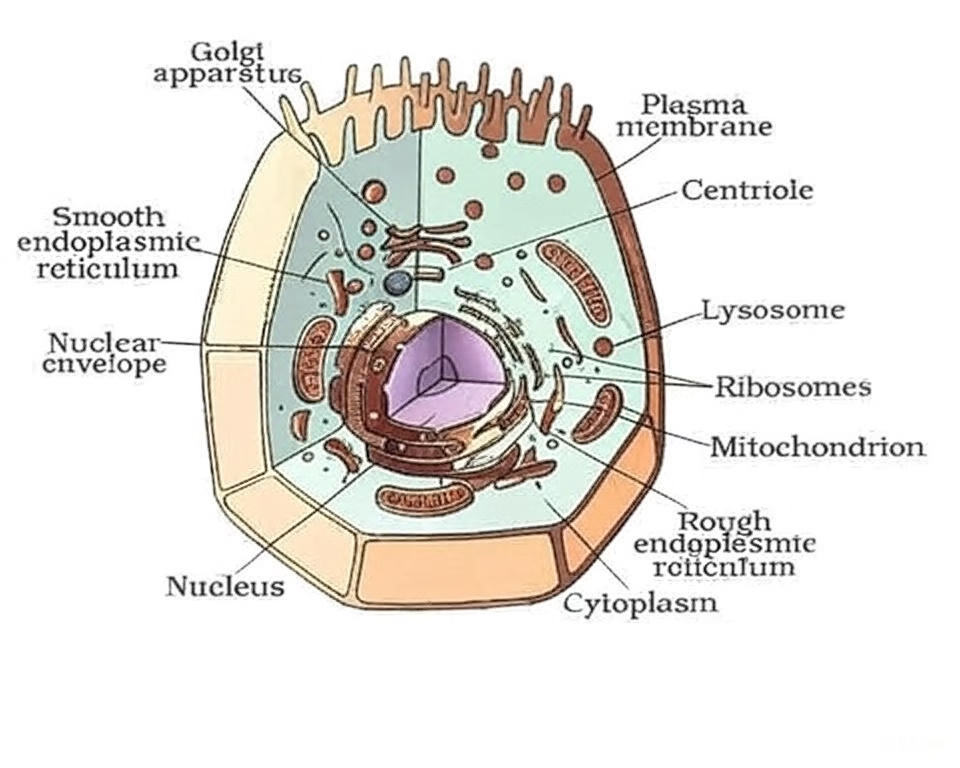
The word ‘cell’ that Robert Hooke used to describe the compartments he saw is derived from a Latin word. What does this Latin word mean?
a) “Building block”
b) “Life form”
c) “Microscopic entity”
d) “A little room”
Answer: d) “A little room”
Who was the first person to observe and name “cells,” and in what year did this discovery occur?
a) Anton van Leeuwenhoek, 1674
b) Robert Hooke, 1665
c) Louis Pasteur, 1864
d) Rudolf Virchow, 1858
Answer: b) Robert Hooke, 1665
When examining a thin slice of cork, Robert Hooke observed structures that he described as resembling a honeycomb. What did he call these “many little compartments”?
a) Units
b) Tissues
c) Organelles
d) Cells
Answer: d) Cells

WHAT ARE LIVING ORGANISMS MADE UP OF
Q4. Who first discovered cells by observing a cork slice with a primitive microscope?
a) Anton van Leeuwenhoek
b) Robert Hooke
c) Robert Brown
d) Rudolf Virchow
Explanation: Hooke’s 1665 discovery laid the foundation for cell biology.
Q5. In what year did Robert Hooke discover cells?
a) 1665
b) 1674
c) 1831
d) 1838
Explanation: Hooke’s discovery was published in his book Micrographia in 1665.
Q6. Which scientist discovered free-living cells in pond water in 1674?
a) Robert Hooke
b) Leeuwenhoek
c) Purkinje
d) Schleiden
Explanation: Leeuwenhoek used a powerful handmade microscope to observe single-celled organisms.
Q7. Who discovered the nucleus in a cell in 1831?
a) Purkinje
b) Robert Brown
c) Schwann
d) Virchow
Explanation: Brown identified the nucleus in plant cells, recognizing its importance.
Q8. Who coined the term ‘protoplasm’ in 1839?
a) Purkinje
b) Robert Brown
c) Schleiden
d) Schwann
Explanation: Protoplasm refers to the living content inside a cell.
Q9. Who proposed that all plants and animals are made up of cells?
a) Robert Hooke and Leeuwenhoek
b) Purkinje and Robert Brown
c) Virchow and Schwann
d) Schleiden (1838) and Schwann (1839)
Explanation: These two biologists formulated the Cell Theory.
Q10. What was Virchow’s 1855 contribution to the Cell Theory?
a) Cells are basic units of life
b) All cells have a nucleus
c) Cells contain protoplasm
d) All cells arise from pre-existing cells
Explanation: This completed the modern Cell Theory.
Q11. Which instrument, invented in 1940, revealed complex cell structures?
a) Electron microscope
b) Primitive microscope
c) Improved microscope
d) Magnifying lenses
Explanation: Electron microscopes helped visualize cell organelles like mitochondria and ER.
Q12. What are the basic building blocks of the onion bulb and all organisms?
a) Organelles
b) Nuclei
c) Protoplasm
d) Cells
Explanation: All living things are composed of cells, the structural and functional units.
Q13. Which of these is a single-cell organism that functions as a whole organism?
a) Amoeba
b) Onion bulb
c) Human
d) Nerve cell
Explanation: Amoeba is unicellular yet performs all life processes.
Q14. What primarily determines the shape and size of a cell?
a) Age
b) Organism type
c) Microscope used
d) Function of the cell
Explanation: A cell’s role affects its structure—e.g., nerve cells are long.
Q15. Which cell type has a fixed and peculiar shape?
a) Nerve cell
b) Amoeba
c) Onion cell
d) Pond water cell
Explanation: Nerve cells are long and branched to transmit signals efficiently.
Q16. What characteristic is shared by all living cells?
a) Changing shapes
b) Perform basic life functions
c) Multicellular nature
d) Only specialized roles
Explanation: All cells perform essential activities like respiration and growth.
Q17. The concept of ‘division of labour’ exists
a) In multicellular organisms and within single cells
b) Only in multicellular organisms
c) Only in single cells
d) In non-living and living
Explanation: Both entire organisms and cell organelles share responsibilities.
Q18. What are the specialized structures inside cells called?
a) Tissues
b) Cell organelles
c) Organs
d) Protoplasm
Explanation: Organelles like mitochondria and Golgi body have specific tasks.
Q19. Which of the following is a function of cell organelles?
a) Pumping blood
b) Digesting food
c) Changing shape
d) Making new materials in the cell
Explanation: Organelles help synthesize proteins, enzymes, and other cellular components.
Q20. Why can a cell perform all its functions?
a) Fixed shape
b) Presence of nucleus
c) Ability to move
d) Presence of organelles
Explanation: Organelles carry out digestion, energy production, waste removal, etc.
Q21. All organelles together constitute:
a) The basic unit called the cell
b) The organism
c) The nucleus
d) The protoplasm
Explanation: Organelles make up the functional cell.
Q22. What’s a unique fact about cell organelles across different organisms?
a) Unique to each cell type
b) All cells have same organelles
c) Number varies by organism size
d) Visible with primitive microscopes
Explanation: Basic organelles like nucleus, mitochondria are universal in all eukaryotic cells.
Q23. Which discovery came after the Cell Theory by Schleiden and Schwann?
a) Discovery of nucleus
b) Coining of ‘protoplasm’
c) Free-living cells
d) Virchow’s addition to Cell Theory
Explanation: Virchow’s idea that cells come from pre-existing cells refined the theory.
PLASMA MEMBRANE OR CELL MEMBRANE

🧫 The Cell and Its Functions
Q1. What is the outermost covering of the cell that separates its contents from the external environment?
A) Nucleus
B) Plasma membrane
C) Cytoplasm
D) Cell wall
Answer: B) Plasma membrane
Q2. Why is the cell membrane described as a selectively permeable membrane?
A) It only allows waste products to exit the cell.
B) It is completely impermeable to all substances.
C) It allows only water to pass through it.
D) It allows the entry and exit of some materials while preventing others.
Answer: D) It allows the entry and exit of some materials while preventing others
Q3. Which process describes the spontaneous movement of a substance from a region of high concentration to a region of low concentration across the cell membrane?
A) Diffusion
B) Osmosis
C) Endocytosis
D) Active transport
Answer: A) Diffusion
Q4. How does carbon dioxide (CO₂), a cellular waste, move out of a cell when its concentration is high inside?
A) Through active transport requiring energy.
B) By osmosis, as it follows water movement.
C) By diffusion, from a region of high concentration inside to low concentration outside.
D) Through endocytosis, engulfing the waste.
Answer: C) By diffusion, from a region of high concentration inside to low concentration outside.
Q5. When does oxygen (O₂) enter the cell by diffusion?
A) When the level of O₂ inside the cell increases.
B) When the level or concentration of O₂ inside the cell decreases.
C) Only when the cell expends energy.
D) When water molecules move out of the cell.
Answer: B) When the level or concentration of O₂ inside the cell decrease
Q6. What important role does diffusion play in the life of a cell?
A) Enabling the cell to shrink in concentrated solutions.
B) Facilitating the engulfment of food particles.
C) Pumping blood within multicellular organisms.
D) Gaseous exchange between cells and between the cell and its external environment.
Answer: D) Gaseous exchange between cells and between the cell and its external environment.
💧 Osmosis and Water Movement
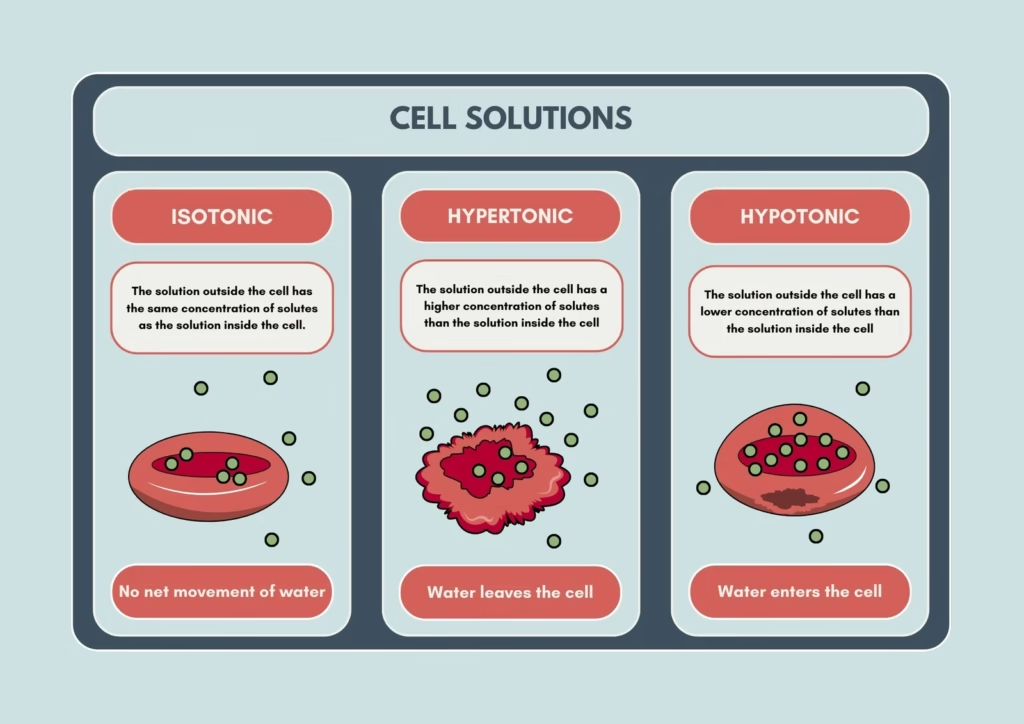
Q7. What is the movement of water molecules through a selectively permeable membrane called?
A) Osmosis
B) Diffusion of solutes
C) Active transport
D) Endocytosis
Answer: A) Osmosis
Q8. How is the movement of water across the plasma membrane affected, according to the sources?
A) By the cell’s energy expenditure.
B) By the flexibility of the membrane only.
C) By the type of organelles present.
D) By the amount of substance dissolved in water.
Answer: D) By the amount of substance dissolved in water.
Q9. Osmosis is defined as the net diffusion of water across a selectively permeable membrane toward what?
A) A region of lower water concentration.
B) A higher solute concentration.
C) A region of lower solute concentration.
D) An isotonic environment.
Answer: B) A higher solute concentration.
Q10. What type of solution causes a cell to gain water by osmosis and potentially swell up because the surrounding medium has a higher water concentration than the cell?
A) Isotonic solution
B) Hypertonic solution
C) Diluted solution (but hypotonic is the specific term)
D) Hypotonic solution
Answer: D) Hypotonic solution
Q11. In a hypotonic solution, water molecules are free to pass across the cell membrane in both directions. What is the net result?
A) Equal amounts of water enter and leave the cell.
B) More water comes into the cell than leaves.
C) More water leaves the cell than enters.
D) No water movement occurs whatsoever.
Answer: B) More water comes into the cell than leaves.
Q12. If a medium has exactly the same water concentration as the cell, what is this solution known as, and what happens to the cell?
A) Isotonic solution; the cell stays the same size.
B) Hypotonic solution; the cell swells up.
C) Hypertonic solution; the cell shrinks.
D) Concentrated solution; the cell gains water.
Answer: A) Isotonic solution; the cell stays the same size.
Q13. What occurs when a cell is placed in a hypertonic solution?
A) The cell gains water by osmosis and swells.
B) There is no net movement of water, and the cell stays the same size.
C) The cell loses water by osmosis and shrinks.
D) The cell actively pumps water out to maintain balance.
Answer: C) The cell loses water by osmosis and shrinks.
Q14. Which statement correctly describes water movement across the cell membrane in a hypertonic solution?
A) More water leaves the cell than enters it.
B) Water only enters the cell.
C) Water only leaves the cell.
D) Equal amounts of water enter and leave the cell.
Answer: A) More water leaves the cell than enters it.
🔁 Transport Mechanisms and Cell Theory
Q15. Osmosis is considered a special case of what fundamental process?
A) Active transport
B) Diffusion
C) Endocytosis
D) Cellular respiration
Answer: B) Diffusion
Q16. Which of the following is an example of osmosis mentioned in the sources?
A) Engulfing food by Amoeba.
B) Gaseous exchange in lungs.
C) Absorption of water by plant roots.
D) Movement of carbon dioxide out of the cell.
Answer: C) Absorption of water by plant roots.
Q17. Besides diffusion for gaseous and water exchange, how else do molecules move in and out of the cell for nutrition?
A) Solely through passive diffusion.
B) Only by engulfing via endocytosis.
C) The sources do not provide this information.
D) Through a type of transport requiring use of energy.
Answer: D) Through a type of transport requiring use of energy.
Q18. What organic molecules make up the flexible plasma membrane?
A) Lipids and proteins.
B) Carbohydrates and nucleic acids.
C) Minerals and vitamins.
D) Sugars and salts.
Answer: A) Lipids and proteins.
Q19. What process involves the cell membrane’s flexibility enabling the cell to engulf food and other material from its external environment, as seen in Amoeba?
A) Diffusion
B) Endocytosis
C) Exocytosis
D) Osmosis
Answer: B) Endocytosis
🔍 Discovery and Structure of Cells
Q20. According to the sources, what are the basic building units of organisms like the onion bulb?
A) Tissues
B) Organs
C) Cells
D) Molecules
Answer: C) Cells
Q21. Who first discovered cells by observing them in a cork slice with a primitive microscope in 1665?
A) Antoine van Leeuwenhoek
B) Theodor Schwann
C) Matthias Schleiden
D) Robert Hooke
Answer: D) Robert Hooke
Q22. Who discovered free-living cells in pond water for the first time in 1674, using an improved microscope?
A) Leeuwenhoek
B) Robert Brown
C) Rudolf Virchow
D) Purkinje
Answer: A) Leeuwenhoek
Q23. In 1831, who was responsible for discovering the nucleus in the cell?
A) Robert Hooke
B) Antoine van Leeuwenhoek
C) Purkinje
D) Robert Brown
Answer: D) Robert Brown
Q24. The term ‘protoplasm’ for the fluid substance of the cell was coined by whom in 1839?
A) Schleiden
B) Purkinje
C) Schwann
D) Virchow
Answer: B) Purkinje
Q25. Which two biologists presented the cell theory stating that all plants and animals are composed of cells and that the cell is the basic unit of life?
A) Schleiden (1838) and Schwann (1839)
B) Robert Hooke and Leeuwenhoek
C) Robert Brown and Purkinje
D) Virchow and Brown
Answer: A) Schleiden (1838) and Schwann (1839)
Q26. Who expanded the cell theory in 1855 by suggesting that all cells arise from pre-existing cells?
A) Matthias Schleiden
B) Theodor Schwann
C) Virchow
D) Robert Brown
Answer: C) Virchow
Q27. What invention in 1940 made it possible to observe and understand the complex structure of the cell and its various organelles?
A) Compound microscope
B) Electron microscope
C) Primitive microscope
D) Magnifying lens
Answer: B) Electron microscope
🧬 Cell Types and Functions
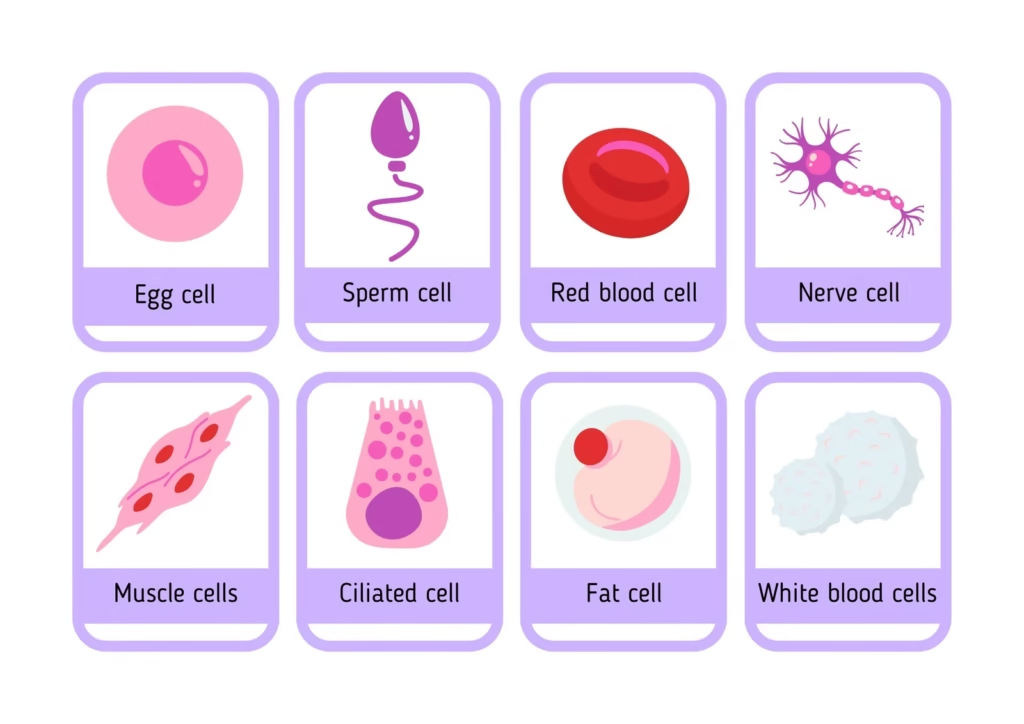
Q28. Which organism is given as an example of a single cell that may constitute a whole organism?
A) Amoeba
B) Onion bulb
C) Human being
D) Nerve cell
Answer: A) Amoeba
Q29. How is the shape and size of cells related, according to the sources?
A) They are fixed for all cell types.
B) They are random and have no specific relation.
C) They are determined solely by the organism’s size.
D) They are related to the specific function they perform.
Answer: D) They are related to the specific function they perform.
Q30. Which type of cell is mentioned as having a changing shape?
A) Nerve cell
B) Amoeba
C) Onion cell
D) Plant root cell
Answer: B) Amoeba
Q31. What is a characteristic feature of all living forms regarding cell function?
A) They only perform functions related to reproduction.
B) They exclusively depend on external energy sources.
C) Each living cell has the capacity to perform certain basic functions.
D) They are unable to clear waste material on their own.
Answer: C) Each living cell has the capacity to perform certain basic functions.
Q32. The concept of ‘division of labour’ within a single cell refers to what?
A) Specific components (cell organelles) within the cell performing special functions.
B) Different cells performing different functions in a multicellular organism.
C) The cell membrane allowing different materials to pass.
D) The process of diffusion and osmosis working together.
Answer: A) Specific components (cell organelles) within the cell performing special functions.
Q33. What are the specific components within a single cell that perform special functions, such as making new material or clearing waste?
A) Protoplasm
B) Nucleus
C) Cell walls
D) Cell organelles
Answer: D) Cell organelles
Q34. According to the sources, why is a cell able to live and perform all its functions?
A) Due to the selective permeability of its membrane.
B) Because of its cell organelles working together.
C) Because of the constant movement of water in and out.
D) Only when it is part of a multicellular organism.
Answer: B) Because of its cell organelles working together.
Q35. What is noted about the organelles found in different cells?
A) Organelles vary greatly depending on the cell’s function.
B) Only specialized cells have organelles.
C) All cells are found to have the same organelles, regardless of their function or organism.
D) Organelles are unique to specific organisms.
Answer: C) All cells are found to have the same organelles, regardless of their function or organism.
CELL WALL

CELL WALL
Q1. Who first discovered cells by observing a cork slice with a primitive microscope?
A) Anton van Leeuwenhoek
B) Robert Brown
C) Robert Hooke
D) Matthias Schleiden
Answer: C) Robert Hooke
Robert Hooke first discovered cells in 1665 when he observed cells in a cork slice using a primitive microscope. Leeuwenhoek later discovered free-living cells in pond water with an improved microscope.
Q2. What is the plant cell wall primarily composed of, which also provides structural strength to plants?
A) Protoplasm
B) Plasma membrane
C) Cellulose
D) Nucleus
Answer: C) Cellulose
The plant cell wall, a rigid outer covering in addition to the plasma membrane, is mainly composed of cellulose, which provides structural strength to plants.
Q3. What phenomenon occurs when a living plant cell loses water through osmosis, leading to the shrinkage or contraction of its contents away from the cell wall?
A) Osmosis
B) Turgor pressure
C) Plasmolysis
D) Cellular respiration
Answer: C) Plasmolysis
When a living plant cell loses water through osmosis, there is shrinkage or contraction of the cell’s contents away from the cell wall, a phenomenon known as plasmolysis.
Q4. Which scientist expanded the cell theory in 1855 by proposing that all cells arise from pre-existing cells?
A) Theodor Schwann
B) Virchow
C) Robert Brown
D) Purkinje
Answer: B) Virchow
The cell theory, initially presented by Schleiden (1838) and Schwann (1839), was further expanded by Virchow in 1855, who suggested that all cells arise from pre-existing cells.
Q5. What is the primary role of cell organelles within a single cell?
A) To allow the cell to absorb water only when dead.
B) To provide structural strength to the entire organism.
C) To change the fixed shapes of specific cells like nerve cells.
D) To perform specific functions, such as making new material or clearing waste, enabling the cell to live and perform all its functions.
Answer: D) To perform specific functions, such as making new material or clearing waste, enabling the cell to live and perform all its functions.
Within a single cell, there is a division of labor among specific components known as cell organelles. Each kind of cell organelle performs a special function, such as making new material or clearing waste material, which allows the cell to live and perform all its functions. It is interesting to note that all cells are found to have the same organelles, regardless of their function or the organism they are found in.
NUCLEUS
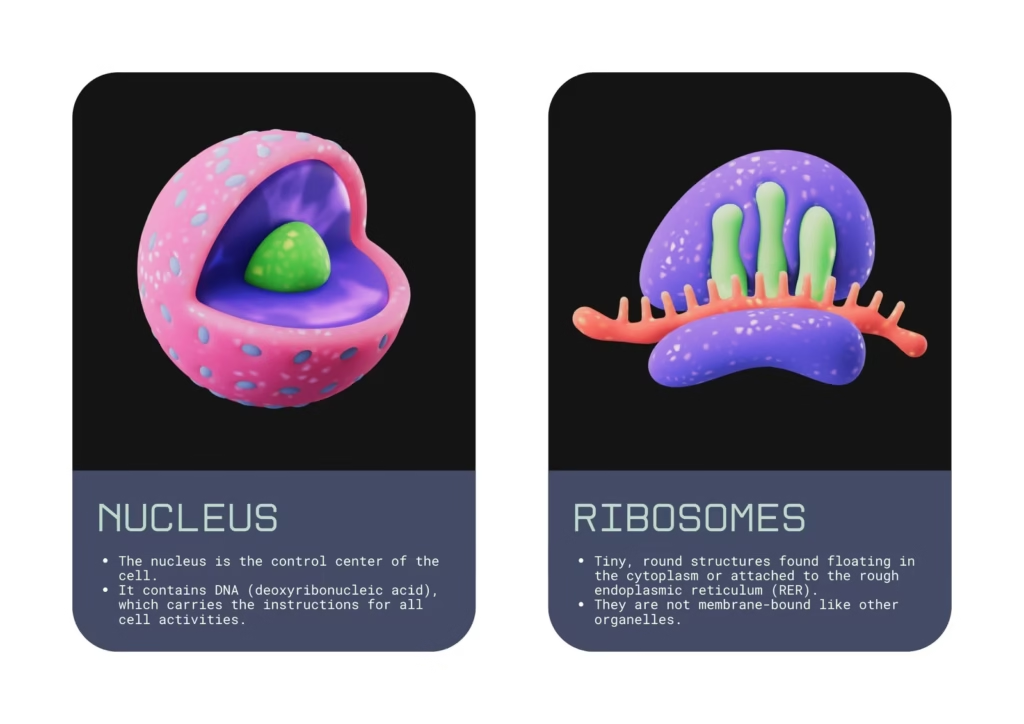
Q1. What solution was specifically mentioned for staining onion peel in the source?
A) Salt solution
B) Sugar solution
C) Iodine solution
D) Water
Answer: C) Iodine solution
Q2. Why was iodine solution put on the onion peel, according to the text?
A) To make it stick to the slide
B) To preserve the cells
C) To differentially color different regions of cells based on their chemical composition
D) To kill the cells quickly
Answer: C) To differentially color different regions of cells based on their chemical composition
Q3. According to the source, what characteristic of cell regions causes them to get colored differentially by stains?
A) Their size
B) Their age
C) Their chemical composition
D) Their location within the tissue
Answer: C) Their chemical composition
Q4. Besides iodine solution, which two other solutions were mentioned as alternatives for staining cells?
A) Bleach and alcohol
B) Water and saline
C) Safranin solution or methylene blue solution
D) Vinegar and oil
Answer: C) Safranin solution or methylene blue solution
Q5. What is the double-layered covering of the nucleus called?
A) Cell wall
B) Plasma membrane
C) Nuclear membrane
D) Cytoplasmic membrane
Answer: C) Nuclear membrane
Q6. What structures are present in the nuclear membrane that facilitate the transfer of material?
A) Gates
B) Channels
C) Pores
D) Valves
Answer: C) Pores
Q7. Material transfer through the nuclear membrane pores occurs between which two parts of the cell?
A) Cytoplasm and cell wall
B) Nucleus and vacuole
C) Inside the nucleus and cytoplasm
D) Nucleus and cell membrane
Answer: C) Inside the nucleus and cytoplasm
Q8. When are chromosomes visible as rod-shaped structures?
A) Always
B) Only during cell growth
C) Only when the cell is about to divide
D) After staining with iodine solution
Answer: C) Only when the cell is about to divide
Q9. Chromosomes contain information for inheritance in the form of what type of molecules?
A) Protein molecules
B) Lipid molecules
C) Carbohydrate chains
D) DNA (Deoxyribo Nucleic Acid) molecules
Answer: D) DNA (Deoxyribo Nucleic Acid) molecules
Q10. Chromosomes are primarily composed of which two components?
A) RNA and protein
B) Lipids and carbohydrates
C) DNA and protein
D) Water and salts
Answer: C) DNA and protein
Q11. What is the primary function of DNA molecules as described in the source?
A) To provide energy for the cell
B) To transport materials within the cell
C) To contain information necessary for constructing and organising cells
D) To protect the cell from external threats
Answer: C) To contain information necessary for constructing and organising cells
Q12. What are the functional segments of DNA called?
A) Alleles
B) Traits
C) Genes
D) Nucleotides
Answer: C) Genes
Q13. In a cell that is not dividing, how is DNA present?
A) As tightly packed chromosomes
B) As free-floating DNA molecules
C) As part of chromatin material
D) As RNA molecules
Answer: C) As part of chromatin material
Q14. How is chromatin material visible in a non-dividing cell?
A) As distinct rod-shaped structures
B) As a smooth, uniform mass
C) As an entangled mass of thread-like structures
D) As a solid, compact sphere
Answer: C) As an entangled mass of thread-like structures
Q15. What happens to the chromatin material whenever the cell is about to divide?
A) It dissolves
B) It duplicates
C) It gets organised into chromosomes
D) It forms a nucleoid
Answer: C) It gets organised into chromosomes
Q16. What central role does the nucleus play in cellular reproduction?
A) It stores all the reproductive cells.
B) It produces hormones for reproduction.
C) It directs the process by which a single cell divides and forms two new cells.
D) It removes waste products from dividing cells.
Answer: C) It directs the process by which a single cell divides and forms two new cells.
Q17. Along with the environment, what crucial part does the nucleus play in determining cell development and its mature form?
A) It provides essential nutrients.
B) It defends against pathogens.
C) It determines the way the cell will develop and what form it will exhibit at maturity.
D) It regulates cell temperature.
Answer: C) It determines the way the cell will develop and what form it will exhibit at maturity.
Q18. How does the nucleus primarily direct the cell’s development and form at maturity?
A) By absorbing light energy
B) By physically shaping the cell
C) By directing the chemical activities of the cell
D) By attracting other cells to form tissues
Answer: C) By directing the chemical activities of the cell
Q19. In some organisms like bacteria, why is the nuclear region of the cell poorly defined?
A) Due to a lack of DNA
B) Due to a lack of cytoplasm
C) Due to the absence of a nuclear membrane
D) Due to the presence of a rigid cell wall
Answer: C) Due to the absence of a nuclear membrane
Q20. What is an undefined nuclear region containing only nucleic acids called?
A) Nucleolus
B) Cytosol
C) Nucleoid
D) Mitochondrion
Answer: C) Nucleoid
Q21. What term is used for organisms whose cells lack a nuclear membrane?
A) Eukaryotes
B) Metazoans
C) Prokaryotes
D) Protozoa
Answer: C) Prokaryotes
Q22. Based on the source, what does the “Pro” in prokaryote signify?
A) Professional
B) Progressive
C) Primitive or primary
D) Protective
Answer: C) Primitive or primary
Q23. According to the source, what does “karyote” (or karyon) refer to in the context of cell classification?
A) Cytoplasm
B) Cell wall
C) Nucleus
D) Membrane
Answer: C) Nucleus
Q24. Organisms with cells having a nuclear membrane are called what?
A) Protists
B) Archaea
C) Eukaryotes
D) Viruses
Answer: C) Eukaryotes
Q25. Compared to eukaryotic cells, what do prokaryotic cells generally lack besides a nuclear membrane?
A) A cell wall
B) Ribosomes
C) Most other cytoplasmic organelles
D) Genetic material
Answer: C) Most other cytoplasmic organelles
Q26. In prokaryotic cells, where are many functions of organelles typically performed?
A) Outside the cell
B) In the cell wall
C) By poorly organised parts of the cytoplasm
D) In the nucleoid
Answer: C) By poorly organised parts of the cytoplasm
Q27. What is chlorophyll in photosynthetic prokaryotic bacteria associated with?
A) Chloroplasts
B) Mitochondria
C) Membranous vesicles
D) Nucleoids
Answer: C) Membranous vesicles
Q28. According to the source, are plastids associated with chlorophyll in photosynthetic prokaryotic bacteria?
A) Yes, always
B) Sometimes, depending on the species
C) No, not with plastids as in eukaryotic cells
D) Only when the cell is dividing
Answer: C) No, not with plastids as in eukaryotic cells
Q29. Which type of cell is characterized by having a nuclear membrane, leading to a well-defined nuclear region?
A) Prokaryotic cell
B) Bacterial cell
C) Eukaryotic cell
D) Viral cell
Answer: C) Eukaryotic cell
Q30. What difference would be observed if an onion peel was viewed without iodine solution, according to the source?
A) It would appear brighter.
B) The cells would be larger.
C) Different regions of the cells might not be colored differentially, making them less distinct.
D) The nuclear membrane would be more clearly visible.
Answer: C) Different regions of the cells might not be colored differentially, making them less distinct.
Q31. What does the acronym DNA stand for?
A) Deoxyribo Nucleic Antibody
B) Duplex Nucleic Acid
C) Dihydroxyl Nucleotide Acid
D) Deoxyribo Nucleic Acid
Answer: D) Deoxyribo Nucleic Acid
Q32. Which cellular structures are responsible for containing the information for inheritance of characters from parents to the next generation?
A) Cell membranes
B) Ribosomes
C) Chromosomes
D) Vacuoles
Answer: C) Chromosomes
Q33. Which of the following is NOT mentioned as a stain for cells in the provided source?
A) Iodine solution
B) Safranin solution
C) Methylene blue solution
D) Crystal violet solution
Answer: D) Crystal violet solution
Q34. The nuclear membrane’s pores allow the transfer of material from inside the nucleus to its outside, which is the:
A) Cell wall
B) Cytoplasm
C) Vacuole
D) Nucleolus
Answer: B) Cytoplasm
Q35. When a cell is about to divide, the chromatin material, which appears as entangled thread-like structures, becomes organized into what?
A) Genes
B) Nucleoids
C) Chromosomes
D) Vesicles
Answer: C) Chromosomes
CYTOPLASM
Q1. What is the cytoplasm primarily described as, according to the sources?
A) The outermost layer of a cell
B) The fluid content inside the plasma membrane
C) A specialized cell organelle responsible for energy production
D) The genetic material located in the nucleus
Answer: B) The fluid content inside the plasma membrane
📝 Explanation: The cytoplasm refers to the jelly-like fluid that fills the cell inside the plasma membrane. It holds all the organelles and is the site of many biochemical reactions.
Q2. Which of the following statements is true regarding cell organelles?
A) They are present only in prokaryotic cells
B) They are generally not enclosed by membranes
C) Each organelle performs a specific function for the cell
D) They take up a significant amount of stain when viewed
Answer: C) Each organelle performs a specific function for the cell
📝 Explanation: Organelles like mitochondria, ribosomes, and endoplasmic reticulum have specific roles—such as energy production, protein synthesis, etc.—making cell functions efficient through division of labor.
Q3. What distinguishes eukaryotic cells from prokaryotic cells in terms of their internal structure?
A) Prokaryotic cells have a defined nuclear region, unlike eukaryotic cells
B) Prokaryotic cells contain membrane-bound cell organelles, while eukaryotic cells do not
C) Eukaryotic cells possess a nuclear membrane and membrane-enclosed organelles, which are absent in prokaryotes
D) Both cell types lack any form of internal membranes
Answer: C) Eukaryotic cells possess a nuclear membrane and membrane-enclosed organelles, which are absent in prokaryotes
📝 Explanation: Eukaryotic cells have a well-defined nucleus and complex organelles enclosed in membranes, whereas prokaryotic cells lack these features and have a simpler structure.
Q4. According to the sources, why do viruses not show characteristics of life until they enter a living body?
A) They lack a defined nuclear region
B) They possess too many specialized cell organelles
C) They require external energy sources from a host cell
D) They lack any membranes
Answer: D) They lack any membranes
📝 Explanation: Viruses are not considered living organisms because they lack a cellular structure, including membranes, and cannot carry out life processes until inside a host cell.
Q5. When observing the cytoplasm in temporary mounts of onion peel or human cheek cells, what characteristic is noted regarding its staining?
A) It takes up a lot of stain
B) It takes up very little stain
C) It does not take up any stain at all
D) Its staining varies greatly depending on the cell type
Answer: B) It takes up very little stain
📝 Explanation: Cytoplasm usually appears faint under the microscope because it does not absorb much stain, making its outline visible but not darkly colored.
CELL ORGANELLES
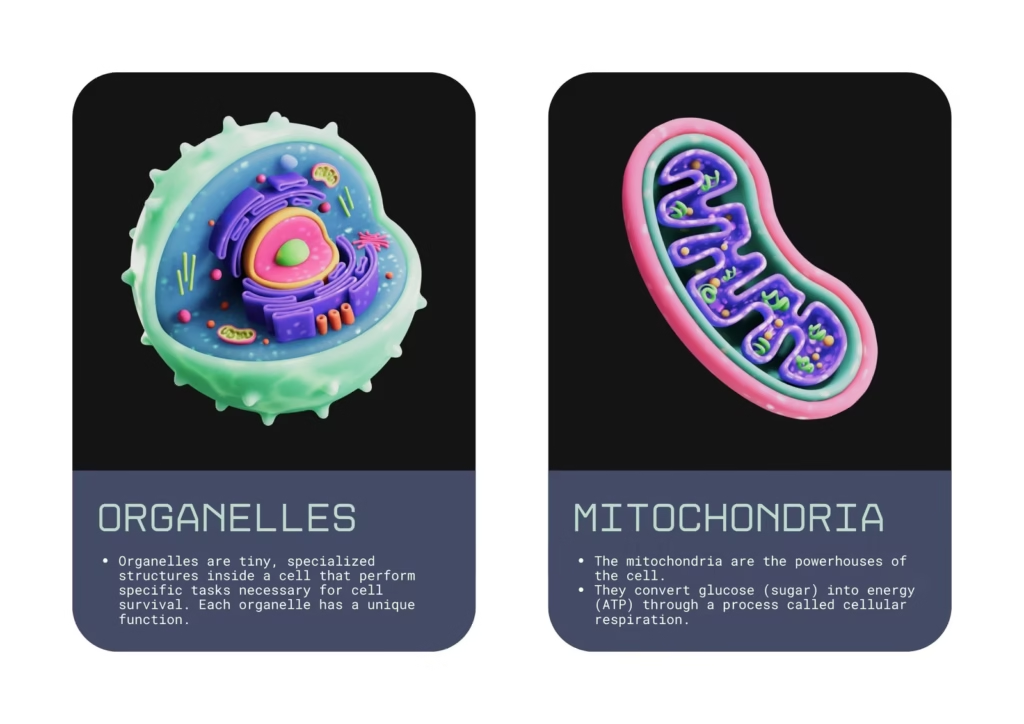
1. What is the primary reason every cell has a membrane around it?
A) To allow all external substances to freely enter.
B) To provide a rigid structural framework for the cell.
C) To keep its own contents separate from the external environment.
D) To facilitate rapid communication with other cells.
Answer: C) To keep its own contents separate from the external environment.
2. Which feature is described as distinguishing eukaryotic cells from prokaryotic cells?
A) The ability to produce their own energy.
B) The use of membrane-bound little structures (organelles) within themselves.
C) Their simple internal structure.
D) The presence of a strong outer cell wall.
Answer: B) The use of membrane-bound little structures (organelles) within themselves.
3. Why do large and complex cells, including those from multicellular organisms, use membrane-bound organelles within themselves?
A) To reduce the total volume of the cell.
B) To make their chemical activities simpler.
C) To increase the overall weight of the cell.
D) To keep different kinds of chemical activities separate from each other.
Answer: D) To keep different kinds of chemical activities separate from each other.
4. According to the source, how are some cell organelles visible?
A) They are visible to the naked eye.
B) Only with an electron microscope.
C) They can be seen using a standard magnifying glass.
D) They are always clearly visible under a light microscope.
Answer: B) Only with an electron microscope.
5. Which of the following is listed as an important example of a cell organelle that carries out crucial functions?
A) Ribosomes.
B) Centrosomes.
C) Mitochondria.
D) Cell wall.
Answer: C) Mitochondria.
GOLGI APPARATUS
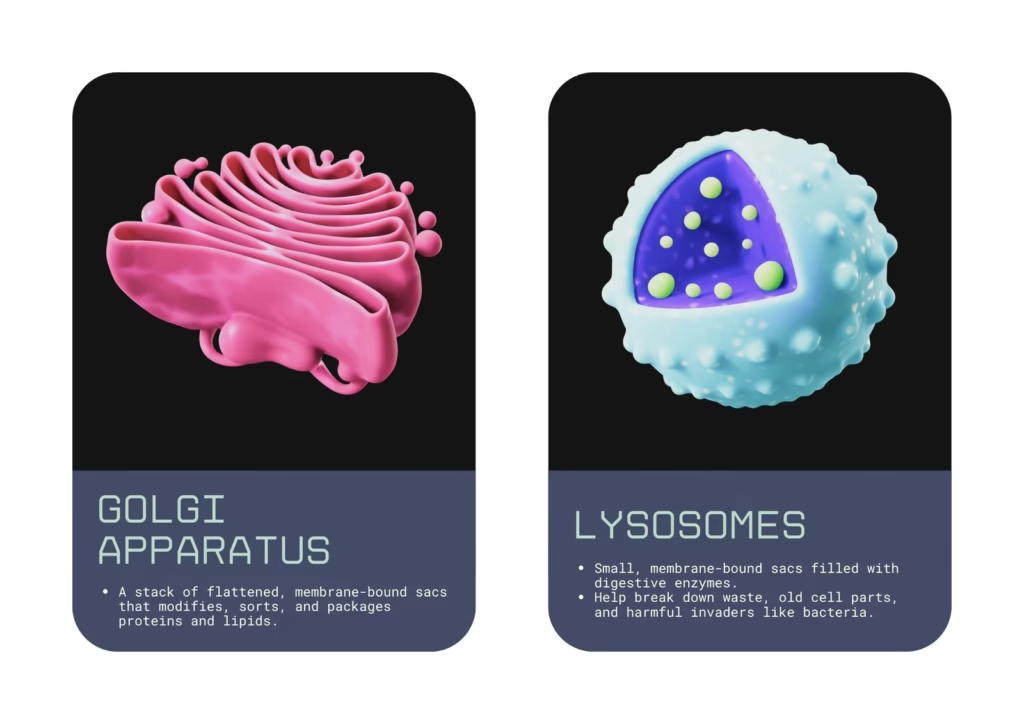
Q1. Who first described the Golgi apparatus?
A) Robert Hooke
B) Anton van Leeuwenhoek
C) Camillo Golgi
D) Matthias Schleiden
Answer: C) Camillo Golgi
Q2. The Golgi apparatus consists of a system of membrane-bound vesicles, which are also described as:
A) Rods
B) Flattened sacs
C) Filaments
D) Tubules
Answer: B) Flattened sacs
Q3. What are the stacks of flattened sacs in the Golgi apparatus called?
A) Cristae
B) Thylakoids
C) Cisterns
D) Ribosomes
Answer: C) Cisterns
Q4. The membranes of the Golgi apparatus often have connections with the membranes of which other organelle?
A) Mitochondria
B) Endoplasmic Reticulum (ER)
C) Nucleus
D) Vacuoles
Answer: B) Endoplasmic Reticulum (ER)
Q5. The Golgi apparatus constitutes another portion of a complex cellular membrane system due to its connections with:
A) Lysosomes
B) Peroxisomes
C) ER membranes
D) The cell wall
Answer: C) ER membranes
Q6. Material synthesized near the ER is dispatched to various targets inside and outside the cell through which organelle?
A) The nucleus
B) The Golgi apparatus
C) The ribosome
D) The chloroplast
Answer: B) The Golgi apparatus
Q7. Which of the following is a function of the Golgi apparatus?
A) DNA replication
B) Energy production
C) Photosynthesis
D) Storage of products
Answer: D) Storage of products
Q8. One of the key functions of the Golgi apparatus involves the ________ of products.
A) Digestion
B) Absorption
C) Modification
D) Respiration
Answer: C) Modification
Q9. The Golgi apparatus is involved in the packaging of products into what structures?}
A) Chromosomes
B) Vesicles
C) Ribosomes
D) Centrioles
Answer: B) Vesicles
Q10. In some cases, complex sugars may be made from simple sugars in which cellular organelle?
A) Mitochondria
B) Ribosomes
C) Golgi apparatus
D) Endoplasmic Reticulum
Answer: C) Golgi apparatus
Q11. The Golgi apparatus is also involved in the formation of which other cellular component?
A) Cell wall
B) Lysosomes
C) Cytoskeleton
D) Nucleolus
Answer: B) Lysosomes
Q12. Material that is packaged and dispatched by the Golgi apparatus is synthesized near which cellular structure?
A) The Golgi apparatus itself
B) The plasma membrane
C) The Endoplasmic Reticulum
D) The cytoplasm
Answer: C) The Endoplasmic Reticulum
Q13. Cisterns, found in the Golgi apparatus, are best described as:
A) Spherical organelles
B) Long, single tubes
C) Stacks of flattened sacs
D) Irregularly shaped sacs
Answer: C) Stacks of flattened sacs
Q14. The Golgi apparatus is considered part of a complex cellular membrane system because it is comprised of membrane-bound vesicles and connects with:
A) The cell nucleus
B) The mitochondrial inner membrane
C) ER membranes
D) The chloroplast thylakoids
Answer: C) ER membranes
Q15. The packaging function of the Golgi apparatus is for dispatching materials to:
A) Only outside the cell
B) Only inside the cell
C) Various targets inside and outside the cell
D) The nucleus exclusively
Answer: C) Various targets inside and outside the cell
LYSOSOMES
What is the structural description of lysosomes?
A) Open-ended tubes for transport
B) Flat discs for energy storage
C) Membrane-bound sacs filled with digestive enzymes
D) Solid, non-membrane-bound structures
Answer: C) Membrane-bound sacs filled with digestive enzymes
Where are the digestive enzymes found in lysosomes primarily made?
A) Golgi apparatus
B) Smooth Endoplasmic Reticulum (SER)
C) Ribosomes directly
D) Rough Endoplasmic Reticulum (RER)
Answer: D) Rough Endoplasmic Reticulum (RER)
What is a primary general role of lysosomes within the cell?
A) Protein synthesis
B) Energy production
C) Genetic material replication
D) Waste disposal system
Answer: D) Waste disposal system
Lysosomes help to keep the cell clean by digesting which of the following?
A) New cell organelles and genetic material
B) Excess water and mineral salts
C) Amino acids and simple sugars
D) Foreign material and worn-out cell organelles
Answer: D) Foreign material and worn-out cell organelles
Which of these are specific examples of materials that are foreign to the cell and end up in lysosomes for digestion?
A) Vitamins and healthy fats
B) Oxygen and carbon dioxide
C) Hormones and neurotransmitters
D) Bacteria or food
Answer: D) Bacteria or food
What enables lysosomes to break complex substances into simpler substances?
A) Their rigid outer membrane
B) Their direct connection to the nucleus
C) Their ability to absorb light
D) The presence of powerful digestive enzymes
Answer: D) The presence of powerful digestive enzymes
The powerful digestive enzymes in lysosomes are capable of breaking down what type of material?
A) Only water-soluble substances
B) Certain types of lipids
C) Only inorganic salts
D) All organic material
Answer: D) All organic material
Under what circumstance might lysosomes earn their nickname, ‘suicide bags’?
A) During normal cellular metabolism
B) When a cell is rapidly dividing
C) To absorb excess nutrients
D) When the cell gets damaged, and lysosomes burst
Answer: D) When the cell gets damaged, and lysosomes burst
If lysosomes burst due to a disturbance in cellular metabolism, what is the immediate consequence mentioned?
A) The cell enters a dormant state
B) New organelles are immediately formed
C) The cell absorbs more foreign material
D) The enzymes digest their own cell
Answer: D) The enzymes digest their own cell
What is another common name for lysosomes, especially when considering their role during cell damage?
A) Waste collectors
B) Energy factories
C) Protein assemblers
D) ‘Suicide bags’
Answer: D) ‘Suicide bags’
MITOCHONDRIA
🧬 Mitochondria – The Powerhouse of the Cell
Q1. What are mitochondria commonly known as within a cell?
a) The cellular nucleus
b) The waste disposal unit
c) The powerhouses of the cell
d) The cellular framework
Answer: c) The powerhouses of the cell
Explanation: Mitochondria are called powerhouses because they release energy by breaking down glucose into ATP, which powers cellular functions.
Q2. What is the specific molecule known as the “energy currency of the cell,” which is released by mitochondria?
a) Glucose
b) DNA
c) ATP (Adenosine triphosphate)
d) RNA
Answer: c) ATP (Adenosine triphosphate)
Explanation: ATP stores and supplies the cell with needed energy for various life processes.
Q3. Which characteristic describes the inner membrane of mitochondria?
a) It is smooth and unbroken
b) It is completely impermeable
c) It is deeply folded
d) It contains chloroplasts
Answer: c) It is deeply folded
Explanation: These folds, called cristae, increase surface area for energy-producing reactions.
Q4. The deeply folded nature of the inner mitochondrial membrane serves what primary purpose?
a) To decrease the overall surface area
b) To protect the cell from external threats
c) To store excess water
d) To increase surface area for ATP-generating chemical reactions
Answer: d) To increase surface area for ATP-generating chemical reactions
Explanation: More folds = more space for enzymes and ATP production = more energy for the cell.
Q5. According to the sources, for what two main purposes does the body use the energy stored in ATP?
a) For regulating cell temperature and storing fat
b) For cellular reproduction and nutrient absorption
c) For making new chemical compounds and for mechanical work
d) For synthesizing proteins and transporting waste
Answer: c) For making new chemical compounds and for mechanical work
Explanation: ATP powers chemical reactions (like making proteins) and physical movement (like muscle contraction).
Q6. Mitochondria are considered “strange organelles” because they possess their own unique components. What are these components that allow them to make some of their own proteins?
a) Vacuoles and lysosomes
b) Cell walls and chloroplasts
c) DNA and ribosomes
d) Nuclei and Golgi apparatus
Answer: c) DNA and ribosomes
Explanation: Mitochondria have their own DNA and ribosomes, allowing partial independence in making proteins.
Q7. How many membrane coverings do mitochondria have?
a) One
b) Three
c) Two
d) Four
Answer: c) Two
Explanation: Mitochondria have a double membrane – an outer membrane and a folded inner membrane.
Q8. What is the characteristic described for the outer membrane of mitochondria?
a) It is rigid
b) It is smooth
c) It is impermeable
d) It is porous
Answer: d) It is porous
Explanation: The outer membrane allows the passage of small molecules needed for respiration.
Q9. Given that mitochondria have their own DNA and ribosomes, what are they capable of doing?
a) Performing photosynthesis
b) Storing genetic information for the entire organism
c) Making some of their own proteins
d) Directly converting light energy into chemical energy
Answer: c) Making some of their own proteins
Explanation: Mitochondria can make several essential proteins required for their energy-making functions.
Q10. In what specific form is the energy required for various chemical activities needed for life released by mitochondria?
a) Glucose
b) Heat
c) Light
d) ATP (Adenosine triphosphate) molecules
Answer: d) ATP (Adenosine triphosphate) molecules
Explanation: ATP molecules are the usable form of energy that power life processes.
PLASTIDS
🌿 Plastids MCQs
Q1. Plastids are cellular organelles found only in which type of cells?
A) Fungal cells
B) Animal cells
C) Bacterial cells
D) Plant cells
Answer: D) Plant cells
Q2. Which two types of plastids are mentioned in the sources?
A) Cytoplasts and Nucleoplasts
B) Chromoplasts and Leucoplasts
C) Amyloplasts and Elaioplasts
D) Mitoplasts and Riboplasts
Answer: B) Chromoplasts and Leucoplasts
Q3. What is the primary function of leucoplasts?
A) To produce chlorophyll for photosynthesis
B) To give plants their vibrant colors
C) To store materials such as starch, oils, and protein granules
D) To regulate water balance within the cell
Answer: C) To store materials such as starch, oils, and protein granules
Q4. Chromoplasts that contain the pigment chlorophyll are specifically called what?
A) Xanthophylls
B) Chloroplasts
C) Carotenoids
D) Leucoplasts
Answer: B) Chloroplasts
Q5. Besides chlorophyll, what other types of pigments can chloroplasts contain?
A) Only green pigments
B) Blue and purple pigments
C) Black and white pigments
D) Various yellow or orange pigments
Answer: D) Various yellow or orange pigments
Q6. What is the material called in which the numerous membrane layers of a chloroplast’s internal organization are embedded?
A) Cytosol
B) Matrix
C) Thylakoid
D) Stroma
Answer: D) Stroma
Q7. Chloroplasts are described as being similar in external structure to which other cell organelle?
A) Nucleus
B) Vacuole
C) Mitochondria
D) Golgi apparatus
Answer: C) Mitochondria
Q8. Like mitochondria, plastids are noted for possessing their own:
A) Cell wall and membrane
B) Nucleus and cytoplasm
C) DNA and ribosomes
D) ATP and glucose
Answer: C) DNA and ribosomes
Q9. Chloroplasts are essential for which vital plant process?
A) Respiration
B) Transpiration
C) Nutrient absorption
D) Photosynthesis
Answer: D) Photosynthesis
Q10. Which of the following is an example of a material stored in leucoplasts, according to the sources?
A) Cellulose
B) Sugars
C) Water
D) Starch
Answer: D) Starch
VACUOLES
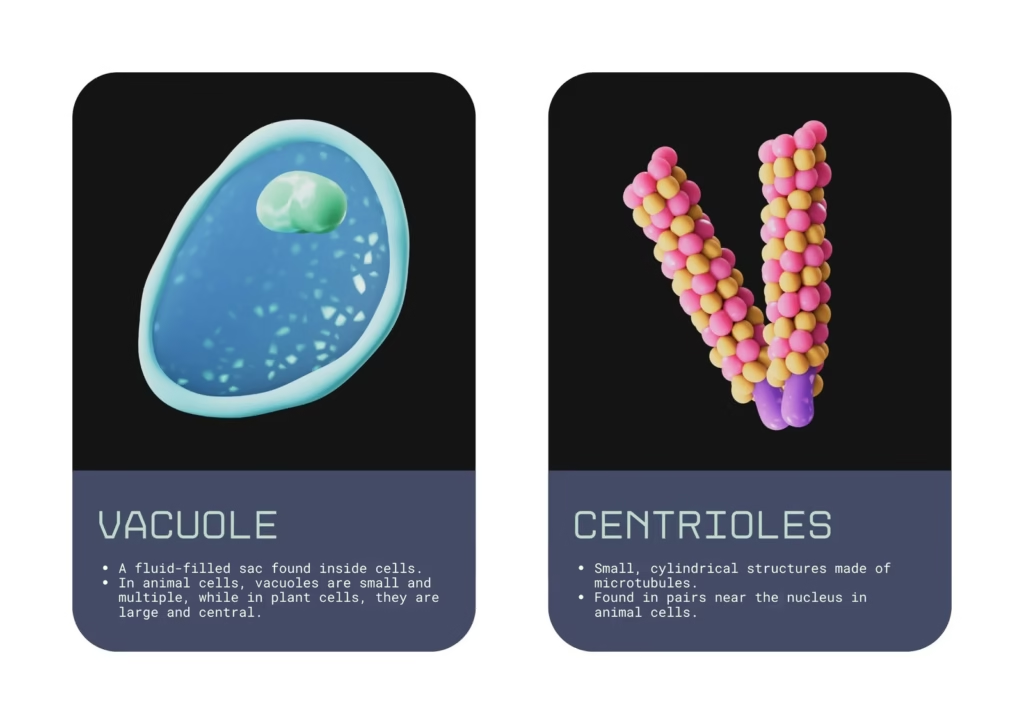
Q1: What are vacuoles primarily known for storing?
A) Genetic codes
B) Electrical impulses
C) Solid or liquid contents
D) Light energy
Answer: C) Solid or liquid contents
Explanation: Vacuoles act like storage bubbles. They store food, water, waste, and other substances the cell might need or dispose of.
Q2: How do vacuoles in animal cells typically compare in size to those in plant cells?
A) They are generally larger.
B) They are usually the same size.
C) They are small sized.
D) Animal cells do not contain vacuoles.
Answer: C) They are small sized
Explanation: Vacuoles in animal cells are smaller and more numerous, while plant cells often have a single large central vacuole.
Q3: What percentage of the cell volume can the central vacuole of some plant cells occupy?
A) 10-20%
B) 30-40%
C) 50-90%
D) Less than 5%
Answer: C) 50-90%
Explanation: In mature plant cells, the central vacuole can expand and occupy most of the cell’s volume, helping in storage and maintaining turgidity.
Q4: A cell acquires its structure and ability to function because of the organization of what two key components?
A) Its cytoplasm and nucleus
B) Its enzymes and hormones
C) Its outer casing and internal fluid
D) Its membrane and organelles
Answer: D) Its membrane and organelles
Explanation: The membrane controls what enters and exits, while organelles carry out specific tasks that keep the cell functioning.
Q5: What fundamental characteristic helps cells perform functions like respiration and obtaining nutrition?
A) Its dynamic fluidity
B) Its complete lack of internal boundaries
C) Its basic structural organization
D) Its random internal arrangement
Answer: C) Its basic structural organization
Explanation: A well-organized structure allows cells to efficiently carry out their vital functions.
Q6: Which of the following is listed as a function that cells perform?
A) Generating light
B) Respiration
C) Converting inorganic matter to organic matter
D) Constructing entire organisms independently
Answer: B) Respiration
Explanation: Cells carry out respiration to release energy from food—this energy fuels all other cell activities
Q7: In addition to respiration and obtaining nutrition, cells are also responsible for what process concerning materials?
A) Accumulation of external pollutants
B) Spontaneous generation of new elements
C) Clearing of waste material
D) Absorbing solar radiation for energy
Answer: C) Clearing of waste material
Explanation: Just like our body, cells need to get rid of waste to remain healthy and functional.
Q8: Cells are capable of forming new what as one of their functions?
A) Minerals
B) Proteins
C) Water molecules
D) DNA fragments from external sources
Answer: B) Proteins
Explanation: Proteins are essential for the cell’s structure and function. Cells synthesize proteins using the instructions stored in DNA.
Q9: The cell is recognized as the fundamental structural unit of what?
A) All chemical elements
B) Only artificial intelligence
C) Non-living substances
D) Living organisms
Answer: D) Living organisms
Explanation: Every living thing, from tiny bacteria to giant trees, is made up of cells.
Q10: Beyond being the basic structural unit, the cell is also described as the basic functional unit of what?
A) The universe
B) Physical matter
C) Life
D) Geological processes
Answer: C) Life
Explanation: All life functions such as growth, repair, reproduction, and metabolism take place in cells.
CELL DIVISION

1. What is one of the primary reasons new cells are formed in organisms?
a) To facilitate energy production
b) To increase the organism’s weight
c) To replace old, dead, and injured cells
d) To convert light into chemical energy
Answer: c) To replace old, dead, and injured cells
2. The two main types of cell division are mitosis and what other process?
a) Photosynthesis
b) Respiration
c) Meiosis
d) Digestion
Answer: c) Meiosis
3. Mitosis is the process by which most cells divide primarily for what purpose?
a) To produce gametes for reproduction
b) To form cells with half the number of chromosomes
c) For growth and repair of tissues
d) To create four new cells
Answer: c) For growth and repair of tissues
4. When a mother cell undergoes mitosis, how many identical daughter cells are typically formed?
a) Three
b) One
c) Two
d) Four
Answer: c) Two
5. In mitosis, how does the number of chromosomes in the daughter cells compare to that of the mother cell?
a) It is half the number
b) It is double the number
c) It is the same number
d) It varies significantly
Answer: c) It is the same number
6. Meiosis is the process by which specific cells of reproductive organs divide to form what?
a) Muscle cells
b) Gametes
c) Bone cells
d) Nerve cells
Answer: b) Gametes
7. How many new cells are produced when a cell divides by meiosis?
a) One
b) Three
c) Two
d) Four
Answer: d) Four
8. The new cells produced through meiosis have what characteristic regarding their chromosome number compared to the mother cells?
a) They have double the number of chromosomes.
b) They have the same number of chromosomes.
c) They have half the number of chromosomes.
d) They have triple the number of chromosomes.
Answer: c) They have half the number of chromosomes
9. Which type of cell division involves two consecutive divisions?
a) Mitosis
b) Budding
c) Meiosis
d) Binary fission
Answer: c) Meiosis
10. The process where new cells are formed is generally called what?
a) Fertilization
b) Respiration
c) Cell division
d) Photosynthesis
Answer: c) Cell division
CONCLUSION: THE FNDAMENTAL UNIT OF LIFE ClASS 9 MCQs
🔁 Come Back Stronger Every Time!
Learning biology isn’t about memorizing facts once — it’s about understanding deeply and practicing smartly. These Class 9 MCQs on The Fundamental Unit Of Life are designed not just to test your knowledge but to strengthen it every time you read them.
So whenever you feel stuck, confused, or even curious — come back to this page. With every revisit, your grip on the chapter will get firmer, your confidence will grow, and your scores will thank you!
👉 Remember: Great students aren’t born. They’re built — one revision at a time. 💪
Read it. Practice it. Master it. Then do it again!

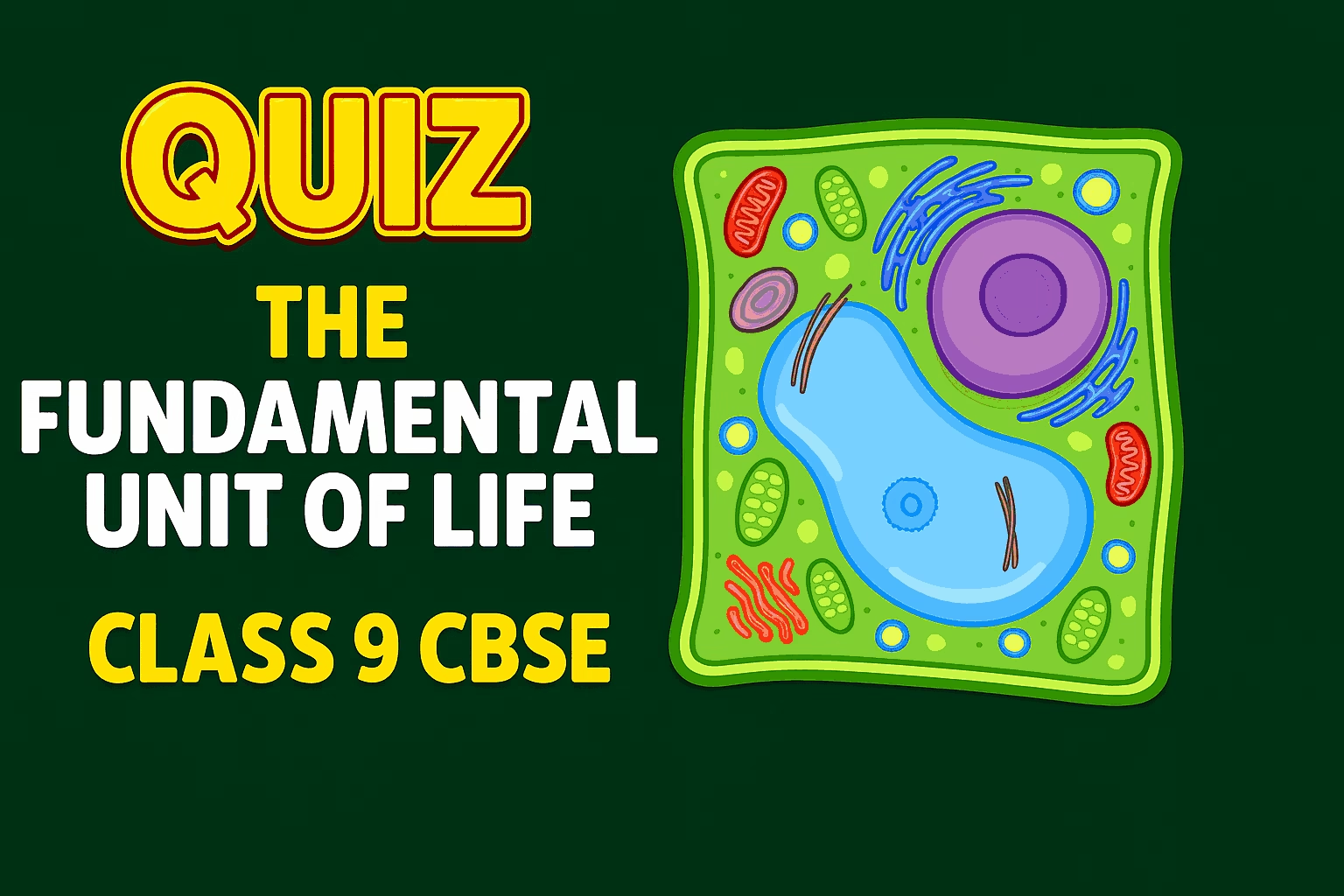

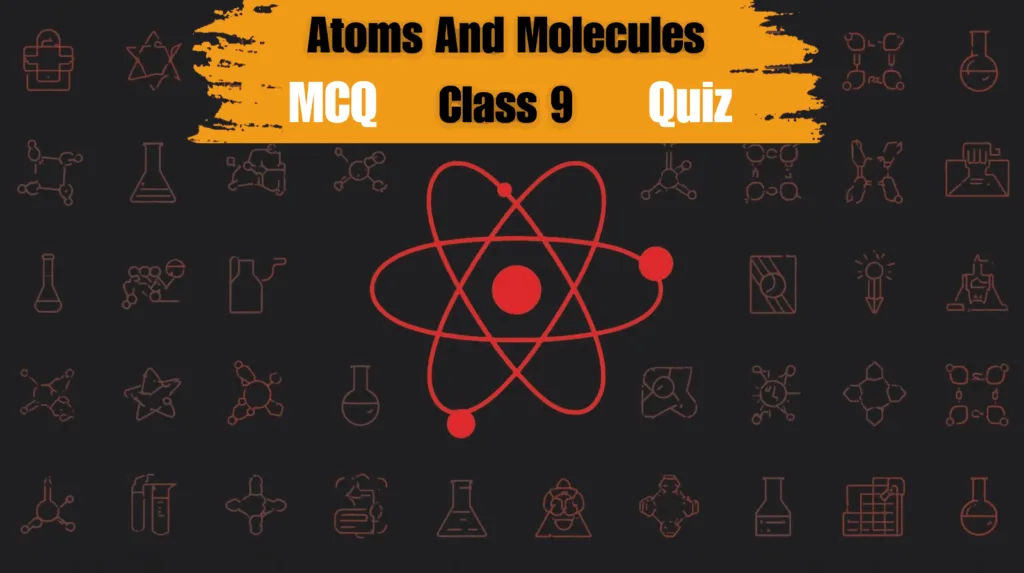


Leave a Comment